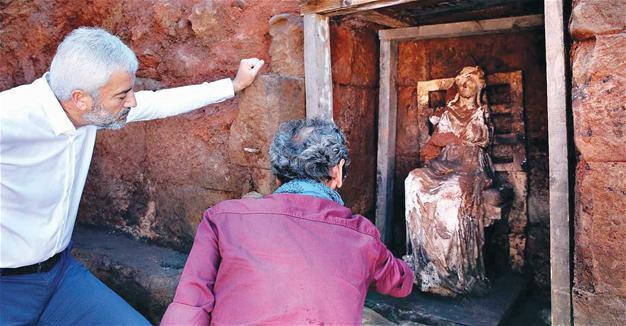Goddess statue, 2,100-year-old castle threatened by dynamite in Turkey's north
Ömer Erbil - ORDU
 One of Turkey’s most important recent archaeological finds faces a grave threat due to blasting activity at a rock quarry in the vicinity.
One of Turkey’s most important recent archaeological finds faces a grave threat due to blasting activity at a rock quarry in the vicinity.A sculpture of the mother goddess of Kybele is threatened by explosions that occur on a daily basis on the outskirts of the 2,100-year-old Kurul Castle, which dates back to the age of Mithridates VI, a king of Pontus and Armenia Minor in northern Anatolia from about 120 to 63 B.C., in the Black Sea province of Ordu.
The castle, located at the peak of the Kurul Rocks in Ordu’s Bayadı village, has been undergoing archaeological excavations under the direction of professor Yücel Şenyurt since 2010.
The discovery of the historic Kybele sculpture during recent excavations caused great excitement, with approximately 15,000 people rushing to the city to view the sculpture. But although archaeological works continue to be conducted on the castle, dynamite is detonated every day on the slope of the Kurul Rocks overlooking the Melet River, creating grave danger for the castle.
In 1996, the Cultural and Natural Heritage Preservation Board declared the castle as a first-degree archaeological and natural site.
The court then canceled the license for the quarry, which had been opened inside the protected site. But in 2011, Kırca Engineering, which operates the quarry, claimed that the quarry and the castle were located on different rocks masses and duly requested that the size of the protected site be reduced.
Although the expert report demanded by the Ordu Administrative Court stated that the quarry could completely destroy the castle, the Ordu Museum and the head of the excavations, Şenyurt, made a different report, stating that the field of the quarry could be excluded from the archaeological site.
Accordingly, the court approved the request to exempt the quarry area from the archaeologically protected zone.
Because of the activities at the quarry, however, rock tombs under the castle are reportedly being destroyed.
Environmentalists react
The head of the Ordu Environmental Association, Gül Ersan, expressed anger that Şenyurt had informed authorities that the quarry would not damage the castle.
“Archaeologists cannot come close to the caves; they are looking at them from a distance. They say that the ceramics that they found close to the quarry might have come from the top. The court asked for an opinion from him and he said it would not harm the archaeological site in his report. The company is continuing to work because of this report,” Ersan said.
Ordu Metropolitan Mayor Enver Yılmaz, who has provided 1 million Turkish Liras to the archaeological excavations, also criticized the situation.
“We increased the ministry’s financial support from 50,000 liras to 1 million. Kybele became the locomotive of the castle. Finding a sculpture in the entrance of the castle shows that more artifacts could be found inside. Some 15,000 people visited the castle in two weeks. The quarry was given a license before I took the post.
Half of this beautiful complex has been damaged. We, as the governor’s office, Culture and Tourism Ministry and the metropolitan municipality, defended nature and the castle during the court process. This damage makes us very sad. We will fix it as soon as possible,” Yılmaz said.
















